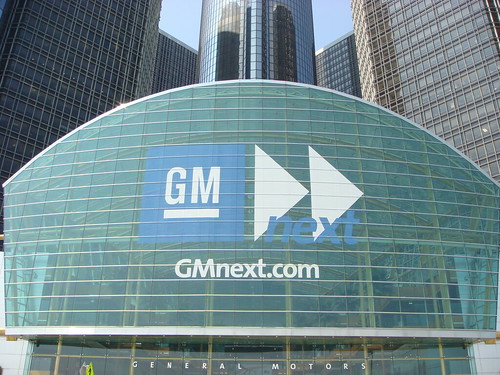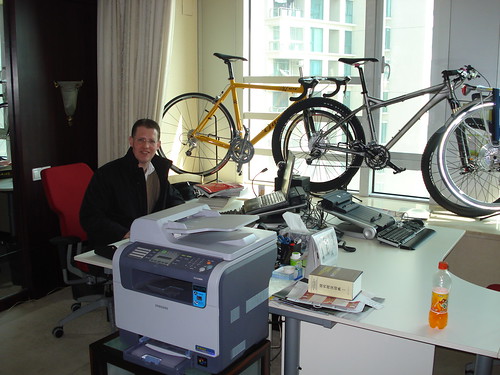Scoopful of GM and Chrysler News – May 11, 2009
Elon Musk, Tesla Motors’ CEO: Once The Electric Charge Dies, The Chevy Volt Is Like A Lawnmower…
GM Hires Search Firm for New Board GM has hired a search firm to help find replacements for at least half of its 12 directors, reflecting Obama’s increasing influence over the auto maker
Transportation Headlines for Monday May 11, 2009…GM Stick to Fuel-Cell Plans as Obama Guts Hydrogen FundsBloombergImagine If People Really Drove the Speed LimitLA StreetsBlogI still believe in public transportationOC MetblogsPort proposed expansion expected to draw a crowd to the Long Beach councilPress TelegramSan Jose and LA Use Technology to Ease Downtown Parking CongestionPublic CEOSan Mar..
Experts call GM bankruptcy ‘almost inevitable’ [w/POLL]…GM, Earnings/FinancialsTo stave off bankruptcy, General Motors must rework its union contracts, drastically cut its capacity, workforce and dealer networks – and convince creditors to take 10 cents on the dollar on $27 billion in unsecured debt. In two months. That’s a herculean task for any company, much less for a monolith the size of The Gene…
Review: 2009 Chevrolet Corvette ZR1 goes to Hell and back…just as GM reached the pinnacle of high performance cars, the world economy imploded. The global financial bubble got pierced from multiple sides and sales of cars at every price and performance level vaporized. Fortunately for us, GM is still hanging in there and Chevrolet let us have a few days of quality time with a ZR1 while the opportunity …
GM: Mascoma ethanol process works as promised in laboratory testing…GM: Mascoma ethanol process works as promised in laboratory testing originally appeared on AutoblogGreen on Mon, 11 May 2009 09:49:00 EST. Please see our terms for use of feeds.
2010 Opel Astra Gets “Full Lutz” Skirt-Lift [Spy Photos]…on the GM‘s Delta II architecture, the same as the Chevy Volt. But don’t expect the Astra to come as a plug-in or standard hybrid, at least, not at first. Do expect to see a new 1.4-liter, turbocharged gasoline/petrol engine with various power outputs. Opel will likely be reserving its 2.0-liter engine for an OPC version (or the Astra VRX for Va…
Latest findings says cars more affordable now than they have been since study began in 1979…GMWhile tanking auto sales are bad for automakers, the customers buying cars and trucks are paying less for them than any time in the past 30 years. Comerica Bank’s Auto Affordability Index shows that a vehicle with a $26,000 MSRP takes the average family 21.5 weeks of median income to buy. That’s 1.3 weeks less than in December of 2008, as ince…
 Rumormill: Suzuki to join Marchionne’s Fiat/Chrysler/Opel super-group…forces with Chrysler, Opel, Saab and General Motors Latin America, the Italian auto group is expanding its home base to the United States, Germany, Sweden and South America. So what’s it missing? Japan. The latest rumors out of Automotive News Europe could go a long way towards addressing that omission, as the trade organ is reporting that Fiat …
Rumormill: Suzuki to join Marchionne’s Fiat/Chrysler/Opel super-group…forces with Chrysler, Opel, Saab and General Motors Latin America, the Italian auto group is expanding its home base to the United States, Germany, Sweden and South America. So what’s it missing? Japan. The latest rumors out of Automotive News Europe could go a long way towards addressing that omission, as the trade organ is reporting that Fiat …
Fiat’s partnership with Chrysler could bring the Ford Ka to America…partnership with Chrysler could actually allow Ford to bring its small and super efficient Ka city car to the U.S. market. How so?The latest version of Ford’s diminutive Ka shares its basic underpinnings with the Fiat 500, which is one of the first small cars Fiat hopes to sell in the United States through Chrysler‘s under-utilized dealer networ…
Driving the Dodge Circuit, now with video…works for Chrysler‘s ENVI and was project lead on the Dodge Circuit EV, talk about the car. The bumpy roads weren’t quite long and straight enough for our liking, but at least we got to learn a little bit more about Chrysler‘s EV strategy and why the automaker thinks it’s ENVI battery strategy is better than Tesla’s. Having driven both the Circu…
LOOK: The Motorless City…or Chrysler’s; they move instead on Schwinns, BMX’s, and behind some of the 600 horses that pull the town’s quaint Victorian carriages. It’s a place that looks, in some respects, frozen in time. But…
Rumormill: Could the Fiat-Chrysler deal yield a North American Ford Ka?…Chrysler, LLC., Ford, FIAT, Rumormill The 2009 Ford Ka – Click above for a high-res gallery It’s a long shot, but according to The Detroit Free Press, Chrysler‘s deal with Fiat could result in Ford offering the cutesy Ka for sale in North America. As you may recall, Ford co-developed the Ka’s platform with Fiat (it shares its chassis with the 5…
2011 Chrysler 300C Reveals Previously Unseen Clay Rump [Spy Photos]…Chrysler‘s Viability Plan earlier this year revealed the design direction for the 2011 Chrysler 300C. Now, thanks to Chrysler PR, we’ve got a partial view of the new Detroit gangsta-mobile’s rump. Also depicted is a quarter scale clay model just above the head oChrysler‘s Senior VP of Design Ralph Gilles. Seeing as it’s in quarter scale, it doe…
Dodge Pulls Plug On Circuit EV Electric Sports Car? [Over The Back Fence]…month after Chrysler ran a full page ad in our national newspapers and also finalizing a deal with A123 Systems to supply the battery packs, a heavy-handed rumor is coming down the stream that the whole project might be dead in the water causing at least one question to be raised: Was the Dodge Circuit EV ever intended for production or was it j…
Cummins not ready to give up on light duty diesel regardless of Chrysler‘s fate…standing was Chrysler, and even that company pushed back its new Cummins-developed light duty diesel until at least 2011. Mike Levine from PickupTrucks.com spoke with Mark Land, director of public relations at Cummins, about the new light-duty diesel engine. Apparently, the diesel engine maker is very confident that its new engine will get adopt…
Chrysler’s sorry state revealed Bankruptcy court filings reveal the complications the auto business – and just how much trouble Chrysler is in.
GM, Chrysler Polish Dealer Cut List Thousands of GM and Chrysler dealerships could learn their fate within the next few days as auto makers choose which they will cut.
Chrysler Hedges on Dealer Cuts Chrysler has “no active plan” to drop any of its dealers in the U.S., although it is working on “contingencies” to do so as part of its restructuring in bankruptcy court, Vice Chairman Jim Press said.
Nascar Feels Chrysler’s Pain The fall of Chrysler is just the latest setback for Nascar, a once red-hot sports phenomenon.








